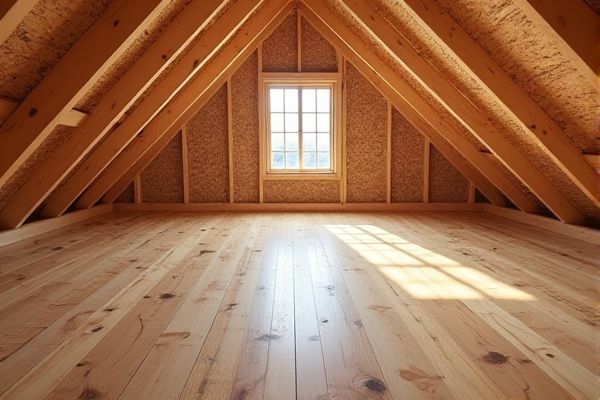
Attic plank flooring offers a rustic, durable option with natural wood grain aesthetics, while plywood flooring provides a more affordable, versatile, and uniform surface suitable for subflooring or finished spaces. Explore the rest of the article to understand which flooring type best fits your attic renovation needs and budget.
Table of Comparison
| Feature | Attic Plank Flooring | Plywood Flooring |
|---|---|---|
| Material | Solid wooden planks, typically pine or oak | Engineered wood sheets made from wood veneers |
| Durability | High durability, withstands heavy loads | Moderate durability, suitable for light to medium loads |
| Installation | Requires nailing or screwing; more time-consuming | Quick installation with tongue-and-groove or adhesive |
| Cost | Higher cost due to solid wood quality | Lower cost, more economical for large areas |
| Moisture Resistance | Lower resistance; prone to warping if exposed | Better resistance due to engineered layers |
| Appearance | Natural wood grain; rustic and classic look | Uniform surface; can be laminated for various finishes |
| Maintenance | Requires regular sealing and polishing | Easier to clean; less frequent maintenance |
| Typical Use | Ideal for traditional attic spaces and renovation projects | Commonly used in modern attics and subfloor systems |
Introduction to Attic Flooring Options
Attic plank flooring offers durability and a traditional aesthetic, made from solid hardwood planks that provide robust support for storage and occasional foot traffic. Plywood flooring, constructed from multiple layers of wood veneers, delivers a cost-effective and stable surface that resists warping and is easier to install in attic spaces. Choosing between attic plank flooring and plywood flooring depends on factors like budget, load capacity, and installation complexity.
What Is Plank Flooring?
Plank flooring consists of long, wide boards made from solid wood, providing a durable and natural surface ideal for attics requiring robust support and aesthetic appeal. Plywood flooring, on the other hand, is manufactured from thin layers of wood veneers glued together, offering a more affordable and stable option with resistance to warping. Your choice between plank and plywood flooring for the attic depends on factors like budget, desired durability, and insulation properties.
Understanding Plywood Flooring
Plywood flooring is composed of multiple layers of wood veneers glued together, providing strength, durability, and resistance to warping, making it an ideal choice for attic floors. Unlike traditional plank flooring, plywood offers a uniform surface that supports insulation and prevents drafts, contributing to better energy efficiency in your home. Understanding plywood's construction helps you choose a flooring material that balances load-bearing capacity with ease of installation in attic spaces.
Installation Differences: Plank vs. Plywood
Attic plank flooring involves fitting individual wooden planks tightly side by side, providing a sturdy and visually appealing surface that requires precise measurement and handling during installation. Plywood flooring consists of large, flat sheets that are quicker to install due to their uniform size and stability, often reducing labor time and complexity. Your choice impacts installation time and skill level, with plank flooring demanding more detailed work compared to the straightforward process of laying plywood panels.
Durability and Strength Comparison
Attic plank flooring typically offers greater durability and strength due to its thicker, solid wood construction compared to plywood flooring's layered composition. Plywood can be more susceptible to warping and weakening over time, especially in humid environments, while plank flooring provides better load-bearing capacity and resistance to heavy foot traffic. Choosing attic plank flooring enhances your attic's structural integrity and ensures long-lasting performance under stress.
Insulation and Energy Efficiency
Attic plank flooring offers superior insulation properties due to its thickness and natural wood density, which helps reduce heat transfer and maintain consistent attic temperatures. Plywood flooring provides moderate insulation but typically requires additional underlayment or insulation materials to match the energy efficiency of plank flooring. Choosing attic plank flooring can enhance overall home energy efficiency by improving thermal resistance and minimizing heat loss through the attic floor.
Cost Analysis: Plank Flooring vs. Plywood
Attic plank flooring generally incurs higher upfront costs compared to plywood flooring due to the use of solid wood planks that offer superior durability and aesthetic appeal. Plywood flooring is more budget-friendly, providing a cost-effective solution with reasonable strength, making it popular for large attic spaces requiring quick installation. Long-term value favors plank flooring as it withstands wear better and may reduce maintenance expenses over time despite the higher initial investment.
Maintenance Requirements
Attic plank flooring demands regular inspection for warping and moisture damage due to its natural wood composition, while plywood flooring requires less frequent maintenance because of its engineered layers resisting humidity and insects. Plank flooring may need periodic sanding and sealing to preserve durability and appearance, whereas plywood typically benefits from occasional cleaning and spot repairs. Overall, plywood flooring offers lower maintenance needs, making it a practical choice for attic spaces exposed to variable environmental conditions.
Best Uses for Each Flooring Type
Attic plank flooring is ideal for creating a rustic or vintage aesthetic, often used in storage spaces, workshops, or loft conversions where durability and character are essential. Plywood flooring offers a versatile, cost-effective solution suitable for subflooring, home renovations, and areas requiring a stable, smooth surface to support finished flooring materials. Both options provide structural support but differ in appearance, weight, and moisture resistance, influencing their best applications.
Which Attic Flooring Is Right for You?
Attic plank flooring offers superior strength and durability, making it ideal for heavy storage or frequent access, while plywood flooring provides a cost-effective, lightweight solution suitable for lighter loads and occasional use. Your choice depends on the attic's intended function, with planks supporting higher weight capacity and plywood excelling in ease of installation and flexibility. Consider insulation and moisture resistance properties as well to ensure the flooring matches your attic's environment and usage needs.
 homyna.com
homyna.com